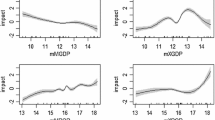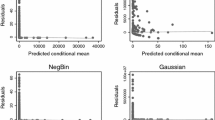Abstract
The gravity equation has been traditionally used to predict trade flows across countries. However, several problems related with its empirical application still remain unsolved. The unobserved heterogeneity, the presence of heteroskedasticity in trade data or the existence of zero flows, which make the estimation of the logarithm unfeasible, are some of them. This paper provides a survey of the most recent literature concerning the specification and estimation methods of this equation. For a dataset covering 80% of world trade, the most widely extended estimators are compared, showing that the Heckman sample selection model performs better overall for the specification of gravity equation selected.
Similar content being viewed by others
References
An G, Puttitanun T (2009) Revisiting McCallum’s border puzzle. Econ Dev Q 23: 167–170
Anderson JE, van Wincoop E (2003) Gravity with gravitas: a solution to the border puzzle. Am Econ Rev 93: 170–192
Anderson JE (1979) A theoretical foundation for the gravity equation. Am Econ Rev 69: 106–116
Anderson JE, Marcouiller D (2002) Insecurity and the pattern of trade: an empirical investigation. Rev Econ Stat 84: 342–352
Andrews M, Schank T, Upward R (2006) Practical fixed effects estimation methods for the three-way error components model. Stata J 6: 461–481
Baier S, Bergstrand J (2009) Bonus vetus OLS: a simple approach for addressing the border-puzzle and other gravity issues. J Int Econ 77: 77–85
Baldwin R, DiNino V (2006) Euros and zeros: the common currency effect on trade in new goods. Center for economic policy research discussion papers no 5973
Baldwin R, Taglioni D (2006) Gravity for dummies and dummies for gravity
Baltagi BH, Egger P, Pfaffermayr M (2003) A generalized design for bilateral trade flow models. Econ Lett 80: 391–397
Bergeijk P, Oldersma H (1990) Detente, market-oriented reform and German unification: potential consequences for the World Trade System. Kyklos 43: 599–609
Bergstrand JH (1985) The gravity equation in international trade: some microeconomic foundations and empirical evidence. Rev Econ Stat 67: 474–481
Bergstrand JH (1989) The generalized gravity equation, monopolistic competition, and the factor-proportions theory in international trade. Rev Econ Stat 71: 143–153
Bergstrand JH (1990) The Heckscher-Ohlin-Samuelson model, the Linder hypothesis and the determinants of bilateral intra-industry trade. Econ J 100: 1216–1229
Bikker A, de Vos A (1992) An international trade flow model with zero observations: an extension of the Tobit model. Bruss Econ Rev 135: 379–404
Bouet A, Mishra S, Roy D (2008) Does Africa trade less than it should, and if so, why?: the role of market access and domestic factors. International food policy research discussion paper no 770
Brun JF, Carrère C, Guillaumont P, de Melo J (2002) Has distance died? Evidence from a panel gravity model. World Bank Econ Rev 19: 99–120
Burger MJ, van Oort FG, Linders GM (2009) On the specification of the gravity model of trade: zeros, excess zeros and zero-inflated estimation. Spat Econ Anal 4: 167–190
Bussière M, Schnatz B (2009) Evaluating China’s integration in world trade with a gravity model based benchmark. Open Econ Rev 20: 85–111
Cafiso G (2008) The Euro’s influence upon trade: rose effect versus border effect. ECB working paper 941
Cheng IH, Wall HJ (2005) Controlling for heterogeneity in gravity models of trade and integration. Fed Reserv Bank St. Louis Rev 87: 49–63
Deardorff A (1998) Determinants of bilateral trade: does gravity work in a neoclassical world? In: Frankel JA (ed) The regionalization of the world economy, 1st edn. University of Chicago Press, Chicago, pp 7–32
De Benedictis L, Vicarelli C (2005) Trade potentials in gravity panel data models. Top Econ Anal Policy 5: 1386–1417
Egger P (2000) A Note on the proper econometric specification of the gravity equation. Econ Let 66: 25–31
Egger P, Pfaffermayr M (2003) The proper panel econometric specification of the gravity equation: a three-way model with bilateral interaction effects. Empir Econ 28: 571–580
Egger P, Pfaffermayr M (2004) Distance, trade and FDI: a SUR Hausman-Taylor approach. J Appl Economet 19: 227–246
Egger P, Larch M, Staub K, Winkelmann R (2011) The trade effects of endogenous preferential trade agreements. Am Econ J Econ Policy 3: 113–143
Feenstra RC (2002) Border effects and the gravity equation: consistent methods for estimation. Scot J Polit Econ 49: 491–506
Fidrmuc J (2008) Gravity models in integrated panels. Empir Econ 37: 435–446
Fratianni M, Hoon-Oh CH (2007) On the relationship between RTA expansion and openness. Kelley School of Business, working paper no 13, Indiana University
Glick R, Rose AK (2002) Does a currency union affect trade? The time-series evidence. Eur Econ Rev 46: 1125–1151
Haq Z, Meilke K, Cranfield J (2010) Does the gravity model suffer from selection bias? Canadian agricultural trade policy research network working paper no 90884
Head K, Mayer T (2000) Non-Europe: the magnitude and causes of market fragmentation in the EU. Rev World Econ 127: 284–314
Heckman JJ (1979) Sample selection bias as a specification error. Econometrica 47: 153–161
Helliwell JF (1996) Do national borders matter for Quebec’s trade. Can J Econ 29: 507–522
Helpman E (1987) Imperfect competition and international trade: evidence from fourteen industrial countries. J Jpn Int Econ 1: 62–81
Helpman E, Melitz M, Rubinstein Y (2008) Estimating trade flows: trading partners and trading volumes. Q J Econ 123: 441–487
Henderson DJ, Millimet DL (2008) Is gravity linear?. J Appl Economet 23: 137–172
Hoon-Oh CH, Selmier WT II (2008) Expanding international trade beyond the RTA border: the case of ASEAN’s economic diplomacy. Econ Lett 100: 385–387
Kavallari A, Maas S, Schmitz PM (2008) Explaining German imports of olive oil: evidence from a gravity model. European association of agricultural economists international congress, August 26–29, 2008, Ghent, Belgium
Leamer E, Stern R (1971) Quantitative international economics. J Int Econ 1: 359–361
Linnemann H (1966) An Econometric study of international trade flows. Dissertation, Netherlands School of Economics
Linders GM, de Groot H (2006) Estimation of the gravity equation in the presence of zero flows. Tinbergen institute discussion papers 06-072/3
Liu X (2009) GATT/WTO promotes trade strongly: sample selection and model specification. Rev Int Econ 17: 428–446
Manning WG, Mulahy J (2001) Estimating log models: to transform or not to transform?. J Health Econ 20: 461–494
Martin W, Pham CS (2008) Estimating the gravity equation when zero trade flows are frequent. MPRA working paper 9453, University Library of Munich
Martínez-Zarzoso I, Nowak-Lehmann F, Vollmer S (2007) The log of gravity revisited (in revision). CEGE discussion paper 64, University of Göttingen
Mátyás L (1998) The gravity model: some econometric considerations. World Econ 21: 397–401
Melitz M (2003) The impact of trade on intra-industry reallocations and aggregate industry productivity. Econometrica 71: 1695–1725
Melitz M (2007) North, South and distance in the gravity equation. Eur Econ Rev 51: 971–991
Micco A, Stein E, Ordoñez G (2003) The currency union effect on trade: early evidence from EMU. Econ Policy 18: 315–356
Rose AK, van Wincoop E (2001) National money as a barrier to international trade: the real case for currency union. Am Econ Rev 91: 386–390
Ruiz J, Vilarrubia JM (2007) The wise use of dummies in gravity models: export potentials in the Euromed region. Banco de España working papers 0720
Schiavo S (2007) Common currencies and FDI flows. Oxford Econ Pap 59: 536–560
Shepherd B, Wilson JS (2009) Trade facilitation in ASEAN member countries: measuring progress and assessing priorities. J Asian Econ 20: 367–383
Siliverstovs B, Schumacher D (2009) Estimating gravity equations: to log or not to log?. Empir Econ 36: 645–669
Santos Silva JM, Tenreyro S (2006) The log of gravity. Rev Econ Stat 88: 641–658
Santos Silva JM, Tenreyro S (2008) Trading partners and trading volume: implementing the Helpman-Melitz-Rubinstein model empirically. CEPR discussion papers 0935
Shepotylo O (2009) Gravity with zeros: estimating trade potential of CIS countries. Kyiv School of economics discussion papers 16
Soloaga I, Winters A (2001) Regionalism in the nineties: what effect on trade?. N Am J Econ Financ 12: 1–29
Wang ZK, Winters LA (1991) The trading potential of Eastern Europe. CEPR discussion paper 610
Wei SJ (1996) Intra-national versus international trade: how stubborn are nations in global integration? NBER working paper 5531
Westerlund J, Wilhelmsson F (2009) Estimating the gravity model without gravity using panel data. Appl Econ 43: 641–649
Wolf HC (1997) Patterns of intra- and inter-state trade. NBER working paper 5939
Yu M (2010) Trade, democracy, and the gravity equation. J Dev Econ 91: 289–300
Author information
Authors and Affiliations
Corresponding author
Rights and permissions
About this article
Cite this article
Gómez-Herrera, E. Comparing alternative methods to estimate gravity models of bilateral trade. Empir Econ 44, 1087–1111 (2013). https://doi.org/10.1007/s00181-012-0576-2
Received:
Accepted:
Published:
Issue Date:
DOI: https://doi.org/10.1007/s00181-012-0576-2




